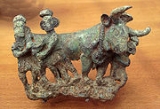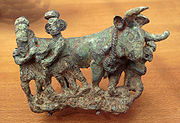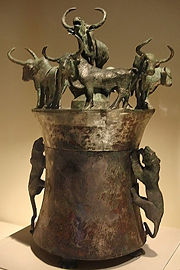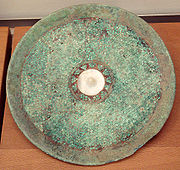
Dian Kingdom
Encyclopedia
 Bronze sculpture depicting Dian people, 3rd century BCE. |
|
| Language Language Language may refer either to the specifically human capacity for acquiring and using complex systems of communication, or to a specific instance of such a system of complex communication... s |
Unknown |
|---|---|
| Religion Religion Religion is a collection of cultural systems, belief systems, and worldviews that establishes symbols that relate humanity to spirituality and, sometimes, to moral values. Many religions have narratives, symbols, traditions and sacred histories that are intended to give meaning to life or to... |
Unknown |
| Capital | Unknown |
| Area Area Area is a quantity that expresses the extent of a two-dimensional surface or shape in the plane. Area can be understood as the amount of material with a given thickness that would be necessary to fashion a model of the shape, or the amount of paint necessary to cover the surface with a single coat... |
Northern Yunnan Yunnan Yunnan is a province of the People's Republic of China, located in the far southwest of the country spanning approximately and with a population of 45.7 million . The capital of the province is Kunming. The province borders Burma, Laos, and Vietnam.Yunnan is situated in a mountainous area, with... , China China Chinese civilization may refer to:* China for more general discussion of the country.* Chinese culture* Greater China, the transnational community of ethnic Chinese.* History of China* Sinosphere, the area historically affected by Chinese culture... |
| Existed | 4th century BCE–109 BCE |
The Dian Kingdom (Chinese: 滇國 or 滇王國) was established by the Dian people, who lived around Lake Dian
Lake Dian
Dian Lake or Kunming Lake is a large inter-land lake located on the Yunnan-Guizhou Plateau close to Kunming, Yunnan, China. Its nickname is "Sparkling Pearl Embedded in a Highland," and it was the model for the Kunming Lake in the Summer Palace in Beijing.It is a freshwater fault lake at above...
in northern Yunnan
Yunnan
Yunnan is a province of the People's Republic of China, located in the far southwest of the country spanning approximately and with a population of 45.7 million . The capital of the province is Kunming. The province borders Burma, Laos, and Vietnam.Yunnan is situated in a mountainous area, with...
, China
China
Chinese civilization may refer to:* China for more general discussion of the country.* Chinese culture* Greater China, the transnational community of ethnic Chinese.* History of China* Sinosphere, the area historically affected by Chinese culture...
from the late Spring and Autumn Period until the Eastern Han Dynasty. The Dian buried their dead in vertical pit graves. The Dian language was likely related to Tibeto-Burman languages.
History

Sima Qian
Sima Qian was a Prefect of the Grand Scribes of the Han Dynasty. He is regarded as the father of Chinese historiography for his highly praised work, Records of the Grand Historian , a "Jizhuanti"-style general history of China, covering more than two thousand years from the Yellow Emperor to...
's Shiji; according to Chinese sources, the Chinese Chu
Chu (state)
The State of Chu was a Zhou Dynasty vassal state in present-day central and southern China during the Spring and Autumn period and Warring States Period . Its ruling house had the surname Nai , and clan name Yan , later evolved to surname Mi , and clan name Xiong...
general Zhuang Qiao was the founder of the Dian Kingdom. Chinese soldiers who accompanied him married the natives. Zhuang was engaged in a war in conquer the "barbarian" peoples of the area, but he and his army were prevented from going back to Chu by enemy armies, so he settled down and became King of the new Dian Kingdom.
The kingdom was located around Kunming
Kunming
' is the capital and largest city of Yunnan Province in Southwest China. It was known as Yunnan-Fou until the 1920s. A prefecture-level city, it is the political, economic, communications and cultural centre of Yunnan, and is the seat of the provincial government...
, it was surrounded, on its east, the Yeh-lang tribes, to the west, Kunming tribes, and to the north in Chengdu
Chengdu
Chengdu , formerly transliterated Chengtu, is the capital of Sichuan province in Southwest China. It holds sub-provincial administrative status...
, by the Chinese, and had relations with all of them.
It is said that during King Qingxiang's (Ching-hsiang) rule over Chu (298 236 BC), a military force was sent on a mission to the area which makes up the present day provinces of Sichuan, Guizhou, and Yunnan which respsectively were the lands of the Ba and Shu, Chinzong, and the Tien. Native women married the Chu soldiers, who stayed in the area.
The Dian were subjugated by the Han Dynasty
Han Dynasty
The Han Dynasty was the second imperial dynasty of China, preceded by the Qin Dynasty and succeeded by the Three Kingdoms . It was founded by the rebel leader Liu Bang, known posthumously as Emperor Gaozu of Han. It was briefly interrupted by the Xin Dynasty of the former regent Wang Mang...
under the reign of Emperor Wu of Han
Emperor Wu of Han
Emperor Wu of Han , , personal name Liu Che , was the seventh emperor of the Han Dynasty of China, ruling from 141 BC to 87 BC. Emperor Wu is best remembered for the vast territorial expansion that occurred under his reign, as well as the strong and centralized Confucian state he organized...
in 109 BC
109 BC
Year 109 BC was a year of the pre-Julian Roman calendar. At the time it was known as the Year of the Consulship of Numidicus and Silanus...
. The Dian King willingly received the Chinese invasion, in the hopes of assistance against rival tribes, it was at this time he received his seal from the Chinese, and became a tributary. The Han Dynasty incorporated the territory of the Dian Kingdom into the Yizhou Commandery, but left the King of Dian as the local ruler, until a rebellion during Han Chao-ti's rule. The Chinese proceeded with colonization, and conquered the Kuming tribes in 86 and 82 B.C., reaching Burma.
Royal burials
The Dian buried their kings at Shizhaishan (discovered in 1954). The burials were identified by the inscription, King Dian's Seal. The inscription was written in seal scriptSeal script
Seal script is an ancient style of Chinese calligraphy. It evolved organically out of the Zhōu dynasty script , arising in the Warring State of Qin...
on a gold imperial seal of investiture given by the Han Emperor. Sima Qian noted that the Dian were one of only two local groups to have received an imperial seal, the other being Yelang
Yelang
Yelang , initially known as Zangke , was an ancient political entity first described in the 3rd century BC that was centered in what is now western Guizhou province, China...
. Both are still known - the Yelang seal emerged in 2007 from a Miao
Miao people
The Miao or ม้ง ; ) is an ethnic group recognized by the government of the People's Republic of China as one of the 55 official minority groups. Miao is a Chinese term and does not reflect the self-designations of the component nations of people, which include Hmong, Hmu, A Hmao, and Kho Xiong...
man in Guizhou, claiming to be the Yelang king's 75th generation descendant.
Bronze working
The Dian people were sophisticated metal workers, casting both bronze and iron. The Dian castCasting
In metalworking, casting involves pouring liquid metal into a mold, which contains a hollow cavity of the desired shape, and then allowing it to cool and solidify. The solidified part is also known as a casting, which is ejected or broken out of the mold to complete the process...
bronze objects using both the piece mould method and the lost wax method. Dian elite burials contained an impressive array of bronze objects, although late Dian burials also contained locally cast iron objects.
Large bronze drums were employed by the Dian to communicate in battle; ritual burials of Dian elites were accompanied by large bronze drums filled with cowrie shells. The tops of the drums were removed and replaced by a bronze lid.
Scythian influences?
Iaroslav LebedynskyIaroslav Lebedynsky
Iaroslav Lebedynsky, born in Paris in 1960, is a French historian of Ukrainian origin, a specialist in ancient warrior cultures of the steppe and the Caucasus, and a prolific author in that field...
and Victor Mair speculate that some Scythians may also have migrated to the area of Yunnan
Yunnan
Yunnan is a province of the People's Republic of China, located in the far southwest of the country spanning approximately and with a population of 45.7 million . The capital of the province is Kunming. The province borders Burma, Laos, and Vietnam.Yunnan is situated in a mountainous area, with...
in southern China following their expulsion by the Yuezhi in the 2nd century BCE. Excavations of the prehistoric art of the Dian civilization of Yunnan have revealed hunting scenes of Caucasoid horsemen in Central Asian clothing. The scenes depicted on these drums sometimes represent these horsemen practicing hunting. Animal scenes of felines attacking oxes are also at times reminiscent of Scythian art both in theme and in composition.
Depiction of Dian society

Many scenes depicted the Dian at war, often riding horses. Archaeological evidence shows that horses had been domesticated by the Dian people as early as the sixth century BC. The bronze lids also depicted the Dian decapitating their enemies (who wore their hair in long plaits).
The Kingdom was based on agriculture, the bronzes also showed head hunting, human sacrifice, and slaves as part of Dian society.
Underwater ruins

Other Artifacts
At Dabona, a site connected with the Dian culture, archaeologists discovered a large double coffin burial; The outer coffin was made of wood and the inner coffin was made of bronze. The inner coffin was shaped like a house and weighs over 157 kg.The Yunnan Provincial Museum
Yunnan Provincial Museum
Yunnan Provincial Museum is located in Kunming, on Wuyi Lu. It houses an exhibition centered on Yunnan's ethnic minorities, as well as a collection of artifacts from tomb excavations at Jinning on the southern rim of Lake Dian.-External links:...
holds many archaeological relics of the Dian culture.
External links
- Pictures of Dian Bronzeware
- More pictures of Dian Bronzeware (from German Wikipedia)

